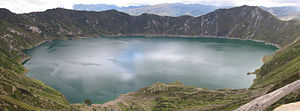 | ||
| Quilotoa | ||
| province | Cotopaxi | |
|---|---|---|
| Residents | unknown | |
| no value for residents on Wikidata: | ||
| height | 3,800 m | |
| no tourist info on Wikidata: | ||
| location | ||
| ||
Quilotoa is the caldera with the crater lake of a volcano and is located in the Cotopaxi Province in the Highlands of Ecuador.
background
Quilotoa is also the name of a small settlement, it is located on the western rim of the crater. The Andean village marks the end of the access road, from here the descent to the laguna begins.
The next larger town is Zumbahua at a distance of approx. 14 kilometers.
Quilotoa has recently developed into one of the most important tourist attractions in the country, the associated infrastructure is being expanded by the responsible Ministerio de Turismo.
The Quilotoa volcano belongs to the Western Cordillera (Cordillera Occidental) and is also the most westerly of the volcanoes in Ecuador, it is almost 4000 meters above sea level. Its last eruption is dated around the year 1280, when its magma flows reached the Pacific, almost 200 kilometers away. After this eruption, the magma chamber collapsed and the huge caldera was created, three kilometers in diameter. Then the lake was created, it is around 250 meters deep. Fumaroles at the bottom of the lake and a slight smell of sulfur on the shore herald the volcanism. There are also some hot springs on the east side of the Quilotoa.
The name is derived from the Quechua language and the word "quiru" for tooth and "Toa" for princess because of the different colors of the water level.
The lake is in Illinois Ecological Reserve, the one around the eponymous mountain in 1996 Illinois designated national park.
getting there
| Distances (road km) | |
| Latacunga | 75 km |
|---|---|
| Ambato | 115 km |
| Quito | 155 km |
In the street
From the open area Quito about the Panamericana, the branch takes place in Latacunga, from here a comparatively well-developed road leads west. However, there are also some major construction sites along this route, and delays that can be longer are to be expected. Then turn off in Zumbahua and continue another 14 kilometers to the visitor parking lot at the caldera.
By bus
There are regular bus connections to nearby Zumbahua during the day Latacunga (Travel time approx. 1.5 hours, $ 3) and also after Quito
mobility

From the visitor parking lot it is still a few meters to a lookout point with a good overall view, where the descent to the laguna begins.
At least four hours should be planned for the 300 mH descent and ascent to the crater rim. Good footwear is required, the steep path is still paved at the top, but further down, it is heavily washed out by the rain in places.
Mules can also be rented for riding ($ 8).
Tourist Attractions
Sights are the caldera and lagoon: depending on the amount of sunlight, the water of the lagoon shimmers in turquoise or emerald green.
The volcanoes are in the distance and in good weather as a background Illinois also the Cotopaxi to see.
 Panorama Caldera and Laguna, the diameter is around three kilometers |
activities
The water of the Laguna would be suitable for bathing, but it has a slightly putrid smell and is very cold.
There is a boat rental.
There is the possibility to walk around the top of the caldera completely, for which you have to plan about five hours of walking.
Around the lake and in the surrounding area there is also a network of trails for hikers and also for horse riding and mountain bikers.
shop
At the parking lot there is a souvenir shop with a wide selection of local handicrafts.
kitchen
- Kirutwa Mushak Wasi (local cuisine) (at the visitor parking lot). Tel.: (0)2-267-0926.
nightlife
There is no night life on site.
accommodation

- Las Cabañas del Quilotoa and Pacha Mama Inn, (Hostal, restaurant). Tel.: 593 (0)9 2125 962.
- Hostal Chukirawa (at the visitor parking lot). Tel.: (0)8 931 3313.
There are also some simple accommodations with the locals in the village.
There is also simple accommodation right on the shore of the lagoon:
- Hospital Princesa Toa

